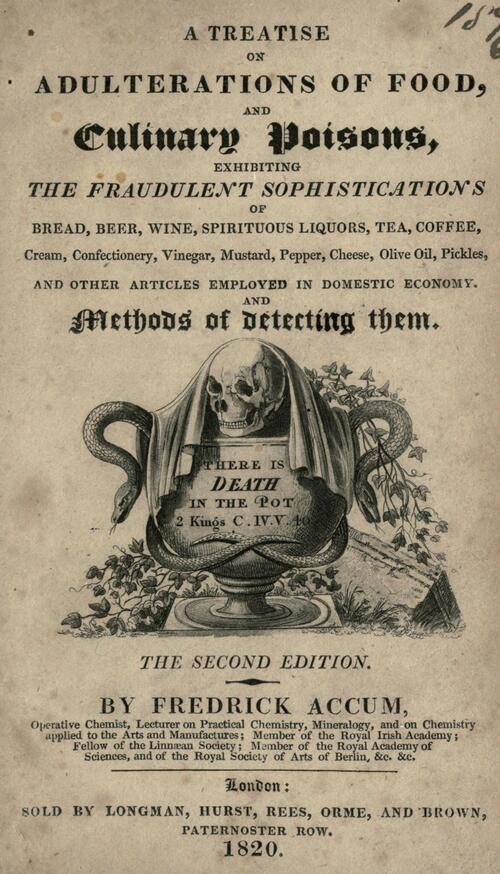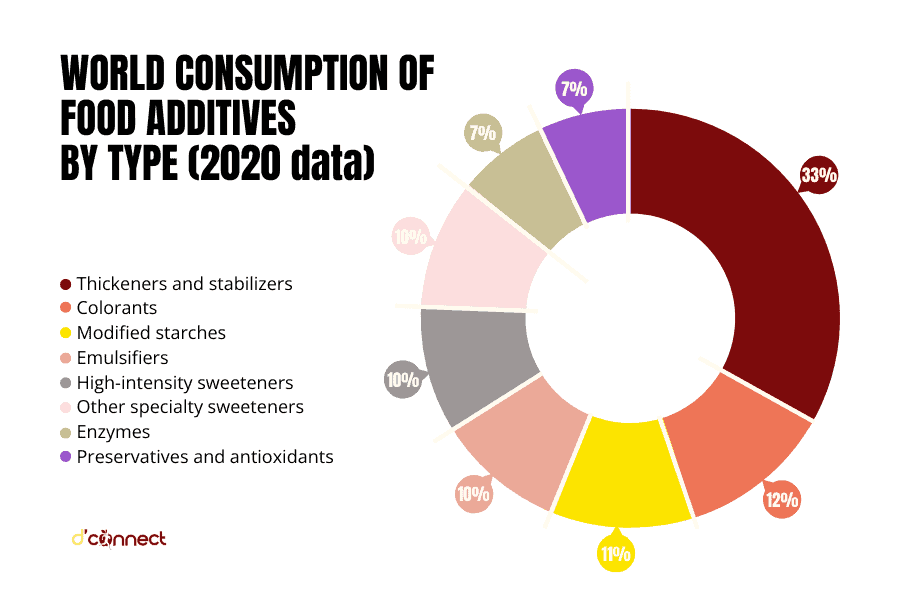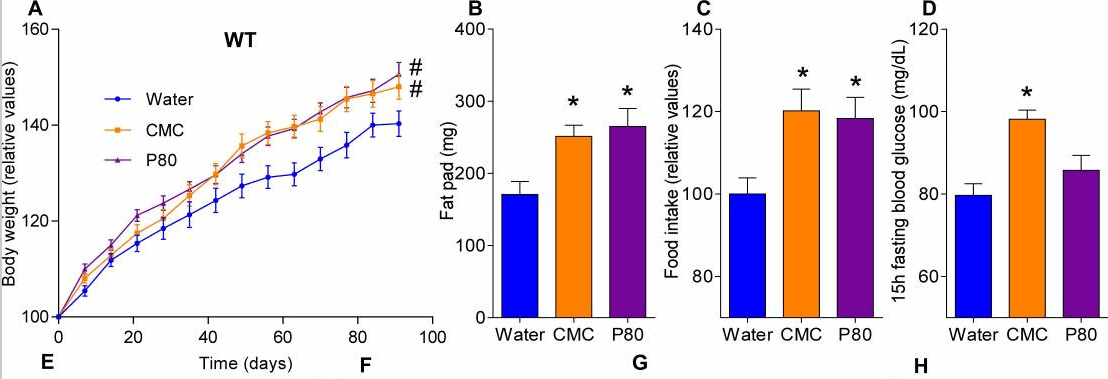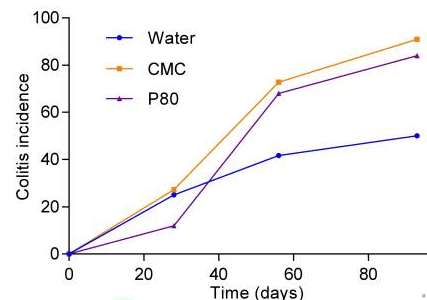
Michaela Dvorakova
(MFood Tech, R&D Specialist)
Food additives are chemical substances added to food to maintain its quality, nutritional value, taste and appearance.
Since the 1950s, the use of additives in food has increased exponentially, to such an extent that a recent European study on 126,000 food products recorded that 53.8% products have at least 1 food additive and 11.3% have at least 5 additives.
With such frequent consumption of food additives, it’s quite reasonable to wonder about the potential negative effects on our health, even concerning food additives that are currently classified as GRAS (Generally Recognised as Safe).
Today, we will zoom in on additives that no longer are classified as GRAS, as studies have shown that some have inflammatory, cancerogenic and tumor-causing properties.
History of food additives
The earliest record of using additives dates back to Ancient Egyptian, circa 1500 BC, when the Egyptians coloured food with saffron.
The first controversy about food colouring cropped up in the Middle Ages. At the time, white bread was more favoured over dark bread since it seemed purer.
However, white bread was more expensive to produce, so bakers started to use different substances, such as chalk (calcium carbonate) or lime (calcium oxide), to make their dark bread whiter, and later started adding potassium aluminium sulphate.
Candy was coloured with copper or mercury

Milk was also processed, in a way where lead chromate was often added since it had a slightly yellowish colour, which would help mask milk that was diluted with water.
In 1820, German chemist Friedrich Accum published Treatise on Adulteration of Food and Culinary Poisons.
That was the first time when the public was informed about using chemical substances in food.
The biggest changes in food additives history was dated in 1902, when Harvey Wiley, chief of the Bureau of Chemistry at the U.S. Department of Agriculture, started with studies on food additives.
This led to creating The Pure Food and Drug Act, which was the first in a series of significant consumer protection laws that led to the creation of the Food and Drug Administration (FDA).[1]
These days the safety of food additives is assessed by agencies such as Food Standards Australia New Zealand (FSANZ), the European Food Safety Authority in the European Union (EFSA) or the United States Food and Drug Administration (FDA).
As we can see on the chart below, the use of food additives in the food industry is on the rise.[2]

Food additives are approved only if there are no harmful effects on the human health at the specific levels and also if there is a good technological reason for using the additive.[3]
Food additives permitted in New Zealand, but banned in other countries
Some additives are permitted for use in Australia and New Zealand, but are banned in other countries. Usually, it’s because of circumstances unique to the country, for example, different dietary exposure.[4]
Another reason can also be the lack of permission. In some cases, manufacturers have never sought permission for the specific additive, because they are using alternatives.
Some of these additives are:
- Amaranth (dye) — banned in 1976 (US) as a suspected carcinogen
- Vegetable carbon — not permitted in the US since it’s shown to cause different types of cancers
- Cyclamate (sweetener) — banned in 1970 (US) as a suspected bladder carcinogen
- Ammonium phosphate — not permitted in the EU
- Ammonium malate — not permitted in the US and the EU.
We are currently working on an article that specifically focuses on this topic, and once it’s published, we’ll share the link here.
Banned Processing Agents and current studies
This group contains emulsifiers, stabilisers, gelling agents, raising agents, bleaching agents or thickeners.
Some agents are added to foods to aid in processing or to maintain the desired consistency of the product. These substances create stiffness, stabilising emulsions or forming gels.
Most side-effects of processing agents are gastrointestinal issues
Processing agents | E code | Risk | Banned |
Calcium sulphite | E226 | Anaphylaxis | – |
Beta-cyclodextrin | E459 | Digestive problems | 1996 |
Brominated vegetable oil (BVO) | E443 | Endocrine disrupter | 2010 |
Ethyl cellulose | E462 | Digestive problems | – |
Crosslinked sodium carboxy methyl cellulose | E468 | Digestive problems | 1960s |
Sucroglycerides | E474 | Digestive problems | – |
Stearyl tartrate | E483 | Digestive problems | 1978 |
Ammonium sulphate | E517 | Digestive problems | 2009 |
Aluminium sulphate | E520 | Digestive problems | 2009 |
Aluminium sodium sulphate | E521 | Digestive problems | 2009 |
Aluminium potassium sulphate | E522 | Digestive problems | 2009 |
Aluminium ammonium sulphate | E523 | Digestive problems | 2009 |
Sodium hydroxide | E524 | Rash, hives, breathing difficulties | – |
Potassium bromate | E924 | Carcinogenic | 1990 |
Azodicarbonamide | E927 | Carcinogenic | 2005 |
Zinc acetate | E650 | Kidney failure | 1996 |
Argon | E938 | Asphyxiation | – |
Helium | E939 | Asphyxiation | – |
Invertase | E1103 | Allergies | 2003 |
Polyvinylpolypyrrolidone | E1202 | Carcinogenic | 2008 |
In 2015, researchers from Atlanta published a study supporting their theory that emulsifiers used in food processing could be promoting inflammatory diseases. This theory was tested on mice using two commonly used emulsifiers:
- carboxymethylcellulose (466), and
- polysorbate-80 (433)
The researchers found these emulsifiers changed the makeup of microbiota in the guts of the mice.
On these graphs you can see the effect of emulsifiers on the amount of bacteria in the stool, effect on body weight of testing animals, as well as effect on fat pad, food intake and level of blood sugar.

This change meant bacteria could now enter and damage the intestinal barrier, a dense mucus layer lining the intestine that is normally able to stop bacteria from passing into the bloodstream. The changed microbiota also meant the production of more inflammatory molecules.

Usually, the amount of emulsifiers in food is very small. For example, the maximum permitted level of microcrystalline cellulose is 5000 mg/kg in dairy products, which is 0.5 %. In the Atlanta study, they were using 1 % solution emulsifiers in water.[5]
Calcium sulphite (banned)
Calcium sulphite is a food additive approved by the European Union (EU) and used as an antimicrobial synthetic preservative in food products and bleaching agent in sugar production.
Calcium sulphite is usually found in canned fruits, pickled fruit, fruit juice, cider or wine. This chemical has also been used as a firming agent and as a disinfectant.
Added sulphites (E221 – E228) should be avoided if individuals are intolerant to natural sulphites. This preservative is banned in Australia and New Zealand due to:
- gastric irritation
- degradation of vitamins B and E
- causing asthma
Asthma symptoms are the most common adverse reaction caused by sulphites. Most studies report a prevalence of sulphite sensitivity of 3–10% among asthmatic subjects who ingest these additives.[6]
Aluminium sulphate (banned)
Aluminium sulphate can be used as a firming agent, sequestrant, pH adjustment and leavening agent in food, such as in pickling, baked goods and cheese.
However, in Australia and New Zealand, this additive is banned.
Aluminium inhibits the uptake of B vitamins
It may also influence liver function in high concentrations. In 2008, scientists from Italy conducted a study focused on the effects of aluminium sulphate in the mouse liver.
In conclusion, prolonged aluminium sulphate intake accelerates features of senescence (biological aging) in adult mice’s liver.[7]
Banned Food Flavourings and current research
Artificial flavours are synthetic chemical substances created to mimic the taste of other ingredients.
Natural flavours, according to the Food and Drug Administration (FDA) Code of Federal, are created from substances extracted from plant or animal sources.
Some animal studies have found that artificial flavours could potentially be detrimental to human health.
Flavourings | E code | Risk | Banned |
Styrene | – | Carcinogenic | 2018 |
Pyridine | – | Respiratory problems | 2018 |
Pulegone | – | Carcinogenic | 2018 |
Myrcene | – | Carcinogenic | 2018 |
Eugenyl methyl ether | – | Carcinogenic, genotoxic | 2018 |
Ethyl acrylate | – | Carcinogenic | 2018 |
Benzophenone | – | Carcinogenic | 2018 |
Ethylene glycol | – | Attack CNS, kidneys | 1998 |
Cinnamyl anthranilate | – | Carcinogenic | 1982 |
One of the studies found a negative effect on the production of red blood cells. In this experiment, rats with a diet containing food colourants mixed with or without flavour additives experienced significant decrease in:
- body weight
- hemoglobin concentration
- red blood cell count
However, for these studies, scientists used more concentrated doses than maximum permitted levels in food, so further research is required.[8,9]
Myrcene (banned)
Myrcene occurs as a major constituent in many plant species, including hops and cannabis. In culinary and perfume use, myrcene’s aroma is earthy, fruity, and clove-like.
β-Myrcene reported beneficial biological activities, which include being analgesic, sedative, antidiabetic, antioxidant, anti-inflammatory or antibacterial. However, β-myrcene is also considered a potential human carcinogen.
In 2010, a 2-year-long animal study on rats recorded an increase of carcinogen in kidneys due to myrcene.[10,11]
The uncertainty of the safety of myrcene led to the ban of this additive in Australia and New Zealand in 2018.
Pulegone (banned)
Pulegone is a monoterpene ketone with a mint-like odour. It is the major component (up to 80–90%) of the essential oil of Mentha pulegium.
Exposure to pulegone was primarily through frozen dairy desserts, candy, baked goods, alcoholic and non-alcoholic drinks, which were flavoured with spearmint oil, peppermint oil or synthetic pulegone.
There are no formal toxicokinetic human studies, but a 2-year-long animal study showed a harmful impact on the kidneys and livers of rodents. Due to these reasons, the use of pulegone as a synthetic flavouring has been banned since 2018. [12]
Related Questions
1. What are 5 most used additives in food processing today?
The most used additives in food processing today are:
- MSG (monosodium glutamate)
- Artificial food colourings
- Sodium nitrate
- Artificial sweeteners
- Corn syrup
RELATED — 5 Most Common Food Additives in our Food (and should we avoid them)? (Part 1)
2. What are the most harmful additives in processed foods?
Overall, consuming small amounts of approved additives may be safe.
But you should definitely be aware of the amount of MSG, artificial food colourings and trans fats in your diet.
3. What is the most unhealthy ingredient in processed food?
Processed food usually contains a high amounts of:
- sugar or high fructose corn syrup
- salt
- trans fats.
Michaela is a qualified food technologist, originally from the Czech Republic, where she successfully graduated and earned a Master’s degree from University of Chemistry and Technology. Michaela’s field of study was chemistry and analysis of food and natural products, and upon finishing her studies she became a part of an R&D team focusing on nutritional plant-based food.
Healthy lifestyle, sustainability, and human and animal well-being are the main reasons why Michaela is interested in natural food and products, with a minimum amount of processing. Also, being such a food lover, she believes that food can be healthy and delicious in equal measure, and at the same time, good and friendly to the environment, which is a win-win for all of us.
References
(1) Food: A Chemical History. Retrieved from https://www.sciencemuseum.org.uk/objects-and-stories/chemistry/food-chemical-history
(2) Food Additives – Specialty Chemicals Update Program (SCUP) | S&P Global (spglobal.com). Retrieved from https://www.spglobal.com/commodityinsights/en/ci/products/chemical-food-additives-scup.html
(3) Food Standards Australia New Zealand. Additives. Retrieved from https://www.foodstandards.gov.au/consumer/additives/additiveoverview
(4) Food Standards Australia New Zealand. Colours and food additives reported as banned. Retrieved from https://www.foodstandards.gov.au/consumer/additives/pages/coloursandfoodadditi5752.aspx
(5) Chassaing B, Koren O, Goodrich JK, Poole AC, Srinivasan S, Ley RE, Gewirtz AT. Dietary emulsifiers impact the mouse gut microbiota promoting colitis and metabolic syndrome. Nature. 2015 Mar 5;519(7541):92-6. doi: 10.1038/nature14232. Epub 2015 Feb 25. Erratum in: Nature. 2016 Aug 11;536(7615):238. PMID: 25731162; PMCID: PMC4910713. Retrieved from https://www.ncbi.nlm.nih.gov/pmc/articles/PMC4910713/
(6) Vally H, Misso NL. Adverse reactions to the sulphite additives. Gastroenterol Hepatol Bed Bench. 2012 Winter;5(1):16-23. PMID: 24834193; PMCID: PMC4017440. Retrieved from https://www.ncbi.nlm.nih.gov/pmc/articles/PMC4017440/
(7) Stacchiotti, Alessandra & Lavazza, Antonio & Ferroni, Matteo & Sberveglieri, Giorgio & Bianchi, Rossella & Rezzani, Rita & Rodella, Luigi. (2008). Effects of aluminium sulphate in the mouse liver: Similarities to the aging process. Experimental gerontology. 43. 330-8. 10.1016/j.exger.2008.01.009.
(8) Sales IMS, Barbosa JS, Silva Dos Santos FK, Carneiro da Silva FC, Ferreira PMP, Marcelo de Castro E Sousa J, Peron AP. Assessment of Grape, Plum and Orange Synthetic Food Flavourings Using in vivo Acute Toxicity Tests. Food Technol Biotechnol. 2017 Mar;55(1):131-137. doi: 10.17113/ftb.55.01.17.4770. PMID: 28559742; PMCID: PMC5434376.
(9) Sales IMS, Silva JM, Moura ESR, Alves FDS, Silva FCC, Sousa JMC, Peron AP. Toxicity of synthetic flavorings, nature identical and artificial, to hematopoietic tissue cells of rodents. Braz J Biol. 2018 May;78(2):306-310. doi: 10.1590/1519-6984.07716. Epub 2017 Aug 17. PMID: 28832835.
(10) National Toxicology Program. NTP technical report on the toxicology and carcinogenesis studies of beta-myrcene (CAS No. 123-35-3) in F344/N rats and B6C3F1 mice (Gavage studies). Natl Toxicol Program Tech Rep Ser. 2010 Dec;(557):1-163. PMID: 21415873.
(11) Surendran S, Qassadi F, Surendran G, Lilley D, Heinrich M. Myrcene-What Are the Potential Health Benefits of this Flavouring and Aroma Agent? Front Nutr. 2021 Jul 19;8:699666. doi: 10.3389/fnut.2021.699666. PMID: 34350208; PMCID: PMC8326332. Retrieved from https://www.ncbi.nlm.nih.gov/pmc/articles/PMC8326332/
(12) European Medicines Agency. Public statement on the use of herbal medicinal products containing pulegone and menthofuran. Retrieved from https://www.ema.europa.eu/en/documents/scientific-guideline/public-statement-use-herbal-medicinal-products-containing-pulegone-menthofuran-revision-1_en.pdf






